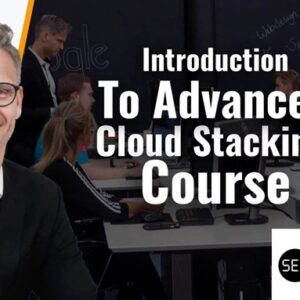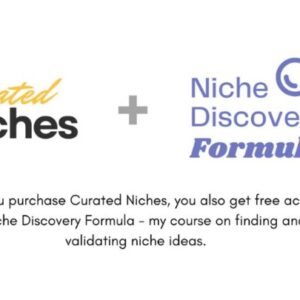Social Media Monetization by Talia Datt (Foundr)
$1,997.00 Original price was: $1,997.00.$29.00Current price is: $29.00.
- Delivery: You Will Receive A Receipt With Download Link Through Email.
- If you need more proof ofcourse, feel free to chat with me!

Sales Page: https://foundr.com/pages/socialmedia-public-sp
Delivery Time: Instant DownloadDescription
Table of Contents
ToggleUnlock Revenue – Social Media Monetization Mastery Awaits. In today’s digital age, the potential of social media monetization is undeniable. It’s no longer just about likes and shares; it’s about transforming your online presence into a predictable source of income. This article explores a comprehensive approach to achieving that, drawing insights from a powerful course designed to help you master the art of turning social media engagement into tangible revenue.
Social media monetization
This article delves into the concept of social media monetization, examining how a strategic approach can transform your online presence into a reliable revenue stream. It goes beyond the surface-level tactics often discussed and focuses on providing a deeper understanding of how to successfully leverage social media for business growth.

The Shift from Engagement to Revenue
Social media was initially conceived as a platform for connection, communication, and sharing. Over the years, it has evolved into a powerful tool for brands and entrepreneurs, offering unprecedented opportunities for marketing and sales. The critical shift, however, lies in understanding that engagement must translate into revenue. Merely posting attractive content that garners likes and shares is insufficient; it’s essential to strategically convert those interactions into paying customers. The core principle here is to view content as “hooks,” designed to guide potential clients to the next stage of their customer journey. This approach requires a deliberate strategy that begins with how content is structured and the value proposition it presents. The most successful businesses today recognize that social media is not just a nice-to-have, but a necessity for sustainable growth, particularly in our digitally-driven world.
The journey from social media engagement to revenue generation is not typically linear and varies across industries and target audiences. However, there are some universal principles. Firstly, understanding your audience is paramount. This allows you to create targeted content that resonates with their needs, interests, and pain points. Secondly, a strong value proposition is vital so that customers see the content and know how it solves an issue in their lives. Finally, leveraging social media algorithms and platform features can dramatically increase content reach and impact. It is important to have a clear strategy, because creating quality content and engaging audiences are only half the battle. Without a clear understanding of revenue channels and conversion tactics, the true potential of social media monetization will not be realized. It really boils down to using social media as a bridge from the online world to your products or services.
The Mindset of a Monetizer
The journey of successfully monetizing social media begins with a fundamental shift in mindset. It’s the transition from simply existing online to operating with a purpose, with the objective of converting engagement into revenue. This approach requires taking a more strategic view of your content and actions across different platforms. It’s about viewing interactions with your audience not just as “likes” or “comments,” but as potential customer insights and opportunities awaiting conversion. The key here is to be intentional, making sure that each piece of content and every engagement strategy serves a specific business goal and is part of a broader plan toward revenue generation. It also involves adopting a mindset of experimentation and continuous improvement, constantly testing different strategies to see what works best for your particular audience and product offering.
Furthermore, an integral part of this mindset is understanding that social media monetization requires long-term thinking, patience and adaptability. Success isn’t typically overnight; it’s an accumulation of strategic efforts and adjustments. This is not the place for fleeting trends but rather the building of an authentic relationship with your audience. Building this is done by delivering consistent value, creating a community, and establishing real connections. It’s also crucial to be able to adapt to the constantly evolving digital landscape. Staying current with trends, algorithm changes, and new platform features is crucial so that you aren’t left behind. Ultimately, the capacity to evolve and the commitment to a long-term vision, combined with tangible plans, are what differentiates those who simply have a social media presence from those who successfully monetize it.
Content as a “Hook” – Opening Doors to Customers
The concept of content as a “hook” is a central theme in social media monetization. The idea is to use your content as a way to draw people into your offering, and, with compelling narratives to guide audience members further into your sales funnel. Each piece of content must have a purpose, whether it’s educating, entertaining, or inspiring, and always with the ultimate objective of opening the door to potential clients. This approach also calls for a more thoughtful approach creating content that moves beyond fleeting trends or solely focusing a singular product. Instead, create content that has a clear goal that aligns with your overall business objectives as it also resonates with your target audience. If this is done well, it can be a powerful tactic.
The power of this approach lies in its subtlety and effectiveness. Content, when done right, can convert consumer curiosity into demand. When someone views your content and they think, “Wow, I have that problem,” you have effectively “hooked” your potential client. By providing consistent value, demonstrating expertise, and authentically connecting with consumers, you can gradually guide them toward using your products or services. It’s about building relationships and trust before directly seeking a sale, and in doing so, establishing a loyal customer base that recognizes the value you provide. In this method of social media engagement, it’s essential to ensure that the “hook” doesn’t just attract attention; it leads toward a clear pathway to becoming a customer.
Amazon influencer course
Many aspiring entrepreneurs and content creators are now looking at an **Amazon influencer cour**se as way to tap into the power of e-commerce and social media. These courses aim at showing aspiring influencers how to leverage their online presence to promote products purchased on Amazon. It goes deeper than simply posting affiliate links, but provides a comprehensive structure and understanding that is required to successfully navigate the landscape of Amazon’s influencer program and e-commerce as a whole.
Understanding the Amazon Influencer Program
At the heart of any successful Amazon influencer course is a detailed understanding of the program itself. The Amazon influencer program allows social media creators to earn commissions by promoting products to their followers. However, the program is more strategic than simply posting affiliate links. It is an ecosystem that involves a complex set of rules, guidelines, and best practices that must be followed to maximize earning potential. A good course will teach the nuances of the program, covering topics such as how to qualify, how to get maximum benefit from the store front, how to create compelling content, how to strategically promote products and how to manage your commissions. Simply put, a solid foundation is crucial if you hope to succeed on the Amazon platform.
A valuable Amazon influencer course should also dive into the different ways you can promote products. It moves beyond simple product links, teaching things like live-streaming, content creation guides, and engaging and connecting with your audience through various content channels. The most effective courses also focus on data and analytics. Knowing what works and what doesn’t is critical, and tracking performance, engagement, and click-through rates are important to know where to tweak your strategy. Additionally, a course may include case studies of successful influencers, providing examples of strategies that have proven successful within the Amazon ecosystem. Ultimately, the goal of an Amazon influencer course is to provide users with comprehensive knowledge and skills, as well as insights to navigate the program and build a profitable streams of revenue.
Content Creation for Amazon Affiliates
Content is king, it cannot be emphasized enough! For Amazon affiliates, this means creating engaging, valuable, and authentic content that resonates with your audience. This requires understanding not just your own audience, but also the type of content that works best on each platform and the unique interests in that given audience. Successful affiliate content is not simply a product promotion, but an integration of products into the context of the creator’s brand and image. The primary objective here is to educate, entertain, or inspire your audience while subtly introducing potential product solutions. The product should be a logical choice for your audience and flow naturally in your content.
A good Amazon influencer course will take a deep dive into different content strategies, helping you learn how to create a variety of videos, reviews, lists, and tutorials. The course may include templates and examples you can use. It should teach how to optimize content to get the maximum benefit from the different social media platforms and ensure your products are seen by target audience members. Learning how to tell a compelling story, effectively utilize relevant keywords, and create authentic content that builds trust and credibility are skills that will pay off in the long run. High-quality production is important, but authenticity and the creator’s unique voice are what make it stand out.
Building a Sustainable Amazon Affiliate Business
Building a sustainable Amazon affiliate business requires long-term strategy and effort. It is not usually a “get rich quick” scheme. The focus must be on establishing a long-term, loyal audience by consistently providing value and building trust. This goes beyond making a quick sale, and emphasizes creating content that will attract more like-minded followers that will want to return to your page. Focus on building community and genuine engagement, with customers that are loyal and trust your recommendations.
Also, it is important be aware that the rules of the Amazon Influencer Program and social media are fluid and change from time to time. If you want long-term success, you must stay knowledgeable and adaptable and be aware of market trends. This means keeping up with the latest program updates, algorithm changes, and audience preferences. Also, this business cannot be treated like a hobby; you must engage with your audience, seek feedback, and consistently analyze your performance. A sustainable Amazon affiliate business is built on the foundation of strategy, continuous learning, and consistent content creation. You also have to understand you probably wont’ be an overnight success. It will take time, but with a well-laid plan, it should be a predictable, steady income.
Found social media
Found social media provides a unique perspective on the landscape of platforms through the lense of business. It’s a method that emphasizes going beyond organic growth to focus on strategic development and monetization opportunities. The platform understands that social media is more than simply a marketing tool. It’s a dynamic ecosystem where brands can connect with their target audience, build a community of followers, and ultimately, drive revenue.
Strategic Platform Usage
Found social media is about far more than simply posting content. It’s about understanding the nuances of different platforms and how to use them strategically. Instagram, TikTok, and YouTube all have their distinct cultures, algorithms, and user demographics. Knowing this means you can customize your approach, content strategies, and targeting preferences. An essential part of this process is determining which platform is best for your type of business and audience, as using them all without any strategy will never be successful. By creating high-quality content that is suited for the platform you choose for your business, you’ll be able to use the platform’s unique features to reach a larger, more engaged audience.
Strategic platform usage also means understanding the importance of timing and frequency of posting. A content calendar, for example, will help ensure that your valuable content is available consistently and at the optimal times to engage your target audience. It also involves analyzing data and using those insights to modify and improve your content. Tracking engagement, reach, and conversions allows brands to fine-tune their approach and adapt to algorithm changes. The fundamental idea here is to see social media platforms not as separate entities, but as a unified network in which every platform is strategically integrated. This allows you to reach your target audience and achieve your business goals.
Beyond Organic Growth – Investing in Reach
Found social media recognizes the limitations of relying solely on organic reach and emphasizes the need for strategic investment in paid advertising. Organic reach, while important for building a foundation, often isn’t enough to achieve substantial growth, especially in a competitive market. Utilizing targeted advertising allows brands to gain visibility and connect with their target consumer demographics. Smart advertisers will take the time to learn how to optimize their campaigns, ensuring that every dollar is used efficiently.
A key aspect of this strategy is understanding your target audience very well. This is done by investing in research and data analysis. This knowledge helps you create advertising campaigns that really speak to your potential clients. Rather than using a generalized reach, investing in an audience-focused approach will almost always yield better results. It also requires adapting to the ever-changing advertising landscape, including changing algorithm, new ad formats, and privacy updates. It’s about going beyond basic ads, and creating engaging content that captures interest and inspires action. The idea is not simply about purchasing views, but about converting potential customers by driving traffic, generating leads, and growing revenue.
Building a Social Media Ecosystem
Found social media is not about using isolated social media platforms, but about creating an interwoven ecosystem. Many businesses make the mistake of only focusing on one platform, but successful brands understand that different platforms can complement each other. By repurposing and cross-promoting content, you can dramatically increase reach and engagement. For example, a video that is published on YouTube can be used as smaller clips on Instagram and TikTok. This content recycling approach increases the visibility of your content and makes sure your brand is seen on multiple channels.
Furthermore, a cohesive ecosystem involves integrating your social media efforts with other areas of the customer journey, such as your website, email campaigns, and in-store experience. This integrated strategy ensures a consistent brand message and a clear sales pathway for consumers. It means that your social media presence is not simply a marketing tactic, but a key part of an overall business strategy. It is about establishing an immersive experience for your customers, who are engaged by the consistent messaging no matter which platform they choose to use.
Brandon von tobel
Brandon Von Tobel is a name which is becoming associated in the industry with innovative approaches to business and marketing. Although he isn’t specifically mentioned as being associated with the course in the briefing document, his focus on modern marketing strategies closely aligns with the principles of effective social media monetization. His views on growth, adaptability, and client relationships help to understand what makes a brand stand out in today’s competitive environment.
The Power of Adaptability in Modern Business
Brandon Von Tobel often emphasizes being adaptable in the ever-evolving world of digital business. This idea completely mirrors the fast-changing nature of social media and its trends. The strategies that achieve success today might not be effective tomorrow, so successful brands must always be learning, adapting, and anticipating market shifts. This adaptability also applies to the content creation process.. A good content strategy is not static, but constantly evolving to meet the changing preferences of your audience. The ability to analyze data, use customer feedback, and make strategic adjustments is imperative for sustainable growth.
Furthermore, adaptability also extends to being comfortable with experimentation. This involves testing new features, platforms, and advertising tactics. Experimentation includes taking calculated risks and being ready to pivot if a strategy isn’t working. You must continuously be open to new methods while simultaneously remaining committed to your overall goals. This mindset is crucial for sustaining competitive advantage in any aspect of your business, but especially in the fast-paced social media world. The brands that aren’t flexible are the ones who are going to be left in the dust.
Building Authentic Relationships
Authenticity is crucial for any brand that hopes to create meaningful relationships with consumers. It means being transparent, genuine, and connecting with your audience on a human level. Consumers do not want to feel marketed to, and appreciate when they can relate to the brand message and company values. This genuine connection builds relationships and trust that can only be created through a sense of shared values. The relationship must move beyond a simple business transaction, as loyal customers become brand advocates when they are treated with respect and appreciation.
For Brandon Von Tobel and the companies he advises, building these genuine relationships requires an integrated approach where customer feedback is actively sought and used to improve. This approach involves not just responding to comments and messages, but engaging in real dialogue. It’s about creating a community around your brand where people feel valued. This focus on human connection and relationship building is crucial when trying to achieve long-lasting success, especially in the digital world where many people are feeling a sense of isolation. Authenticity is not an optional, it is the cornerstone of an engaged audience and customer base.
Data-Driven Decision Making
Data is an important part of all modern business strategies, and Brandon Von Tobel is a strong advocate of data-driven decision making. Data is what allows brands to understand what strategies are working, what strategies are not, when to make changes, and to optimize their campaigns. This approach involves not only tracking key metrics such as engagement, reach, and sales, but analyzing that data to uncover deeper insights. Using analytics tools will allow you to understand which content types are most successful with your audience and where to allocate resources for optimal return.
Using data means not just seeing data in the present moment, but also identifying trends. Doing so means you will be able to make predictions about future performance and modify your strategy to stay ahead of the curve. It’s about being able to make informed decisions rather than depending on intuition alone. A solid understanding of data is crucial for those hoping to succeed in the business world. Using data will allow you to adjust your tactics and strategies as necessary. It also ensures that resources are used efficiently, with results that can be demonstrated effectively. In a world where gut decisions may be insufficient, data provide insights and direction that are fundamental for success.
Gleam alternatives
The briefing document emphasizes the importance of not just creating compelling content but also using tools and strategies for reaching a broader audience. Although not directly associated with the course, tools like Gleam alternatives can enhance the effectiveness of social media strategies and play important roles in campaigns. These tools are crucial for running giveaways and competitions, managing social engagements, and driving traffic. These tools also emphasize the fact that to be successful, you must be strategic about building your audience and driving growth.
The Limitations of Gleam
Gleam is a popular platform used by many brands for running giveaways and contests with a variety of features, but it’s not the right fit for everyone. Some limitations include cost, flexibility, and integration issues. For example, some businesses find their pricing models to be cost-prohibitive, particularly for businesses with smaller budgets or those just starting out. Other platforms may offer more affordable alternatives with many of the same features, allowing businesses to achieve the same results while saving money. Because social media is incredibly flexible, brands must carefully evaluate their needs and budget before committing to any one platform.
Another limitation to consider is the lack of flexibility; some brands have found that their capabilities are rigid and may be difficult to work within. The lack of fully customizable options may limit a brand’s unique needs and creative goals. Integration can be another issue to be considered. Businesses that use other platforms for email marketing or project management may have difficulty connecting with these platforms because of integration constraints. Therefore, the limitations of one platform may mean having to use multiple platforms. For these reasons, many brands are looking into Gleam Alternatives.
Exploring Key Features of Gleam Alternatives
When researching Gleam alternatives, there are several key features that brands should look for. First, the platform should be user friendly with an intuitive interface so anyone can use it. The program should also offer a wide array of customization options so that the giveaways and contests can align with the brand’s identity.. Businesses need to make sure that the alternative provides an option to drive social engagement across a variety of platforms and grow followers across multiple channels..
Additionally, any good alternative should include advanced analytics, giving you the ability to gain insights into campaign performance so you can make informed decision and modify strategy. This includes tracking conversion rates, engagement metrics, and user participation rates. The platform you choose should also make it easy to integrate with other business platforms, such as advertising, analytics, and email marketing. Affordability is always important, and it should be simple to set up and to manage the campaigns so you are saving time and resources. The best Gleam alternatives are those that offer a seamless experience and help you optimize your social media engagement strategies.
Integrating Contest and Giveaways into Marketing Strategy
Contests and giveaways, whether through Gleam or a similar platform, are not just about handing out free stuff. They should be strategically utilized as a part of a wider marketing strategy. When correctly implemented, they can drive engagement, increase brand awareness, and attract a larger audience. The key is to make contests and giveaways relevant and engaging to your target audience, connecting them to your products or services. Strategic planning will ensure that giveaways attract genuine clients that could potentially be converted over time. Many brands also require participants to perform certain actions to enter, so this type of strategy will also increase brand engagement across different platforms.
The right contest or giveaway will also drive sales. For example, by awarding a substantial prize of your product or service, or by giving a limited time discount, you can increase participation while simultaneously giving your business a boost. However, it is also also important to be cognizant of the rules for contests and giveaways in your local jurisdiction so that you comply with them. Effective planning is crucial. While tools like Gleam and its alternatives are useful, it always requires a well planned strategy that is integrated with clear goals, that is carefully monitored. With that type of strategy, you can successfully make contests and giveaways a substantial part of an overall marketing and monetization approach.
Talia Datt
Talia Datt is introduced in the briefing document as the instructor of the social media monetization course and is described as a Forbes 30 Under 30 entrepreneur and a Social Media Maven for her generation. Her experience during the rise of TikTok and ability to connect brands with global creators is a testament to her understanding of social platforms. Her expertise in digital marketing and e-commerce make her uniquely qualified to teach the course.
Social Media Maven for Her Generation
Talia Datt’s designation as a “Social Media Maven for her generation” signals a profound understanding of the latest social media trends. It’s not just about being familiar with existing platforms; instead it is about predicting future trends and being an innovator in an ever-evolving space. Her work in using her skills to connect brands with global creators demonstrates skills in strategic thinking, creative marketing, and effective network building. Her story illustrates a mastery of social media beyond just basic engagement, showing a true understanding of how to strategically monetize through genuine connections.
Her credibility is further cemented by her presence in the Forbes 30 Under 30 list, which is a big indication of her business achievements. She’s more than just another social media influence; she embodies the skills to turn social media into a lucrative business for anyone who wants to follow her course. Her insights into what works and doesn’t work are the product of real experience, and not just theoretical knowledge. These experiences makes her the perfect instructor for brands who want to grow their business on social media.
E-commerce and Digital Marketing Expertise
Talia Datt’s experience in e-commerce and digital marketing is a key ingredient for her social media monetization course. She has experience with many different stages of a business. From conceptualizing an idea of the business, to going to market, to managing sales and growth, to strategic marketing, she has real understanding of what it takes to grow and scale a business online. Her understanding of e-commerce ensures that the course will be very useful for building an online business, as this is directly applicable for many of her students seeking to monetize through social media.
Her vast experience in digital marketing also means she has a solid understanding of how social media fits into a wider marketing strategy. This understanding not only encompasses organic reach but also paid advertising, email campaigns, and data analytics. A course which is based in real-world experience will teach her students how to not focus solely on social platforms, but also show it as part of the whole business ecosystem. This allows her to provide valuable insights far beyond the basic functions of posting content, and ensures that students learn exactly what it takes to build a sustainable and profitable business using social media.
Teaching Approach and Course Structure
The course that Talia Datt teaches includes real-world application and is not merely theoretical. It includes many case studies demonstrating her teaching methods, allowing course takers to understand the practical strategies that are needed to monetize social media. The modules are thoughtfully built to cover essential topics for monetization. This ranges from setting business goals, to building up your content strategy and engaging in meaningful ways with consumers. She also demonstrates how to create compelling and sharable content, and how to leverage the power of the platforms, showing a practical approach to monetizing social media.
The course outline, with modules focused on social media vision, content strategy, and engagement, is designed to provide a step-by-step understanding of how to monetize. As a master of the platform, Talia Datt provides invaluable insights into the strategic thinking needed to succeed in this area. Her ability to simplify sophisticated concepts into understandable steps is part of what makes her an exceptional instructor, and what will make the course engaging for everyone, regardless of what stage their entrepreneurial efforts are in.
Conclusion
In conclusion, the world of social media monetization offers immense opportunities for entrepreneurs and businesses looking to grow and reach a wider audience. By adopting a strategic approach, businesses can go beyond surface-level tactics and use social media to create concrete revenue streams. A course that is taught by experts, such as Talia Datt, with practical real-world applications. With a detailed strategy, adaptable mindset, authentic relationships, and use of data to make decisions, businesses can truly unlock their social media potential and achieve sustainable growth.
Related products
-
Sale!

Jesper Nissen – Advanced Cloudstack For SEO Course
$197.00Original price was: $197.00.$24.50Current price is: $24.50. -
Sale!

Niche Discovery Formula and Curated Niches List
$79.00Original price was: $79.00.$29.00Current price is: $29.00. -
Sale!

[GroupBuy] Stefan Georgi – VSL Blueprint Bundle
$297.00Original price was: $297.00.$72.00Current price is: $72.00. -
Sale!

Robby Blanchard Commission Hero AI
$997.00Original price was: $997.00.$39.00Current price is: $39.00.

Reviews
There are no reviews yet.